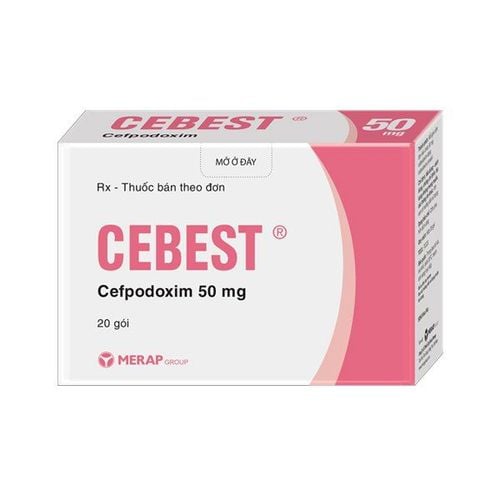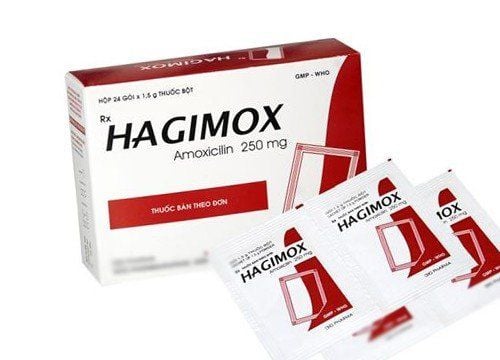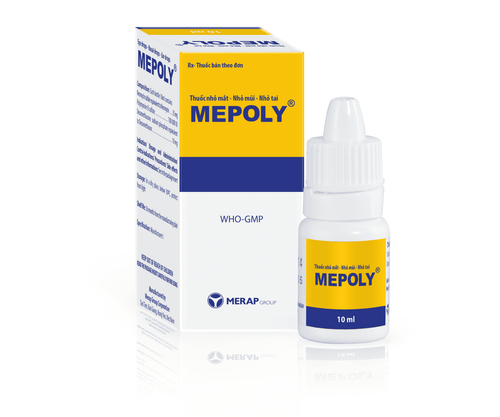This is an automatically translated article.
Biacefpo 200 drug with the main active ingredient is Cefpodoxime, a 3rd generation cephalosporin antibiotic, indicated in the treatment of infections caused by susceptible bacteria. Let's learn about the use of Biacefpo 200 through the article below.
1. What is Biacefpo 200?
Active ingredient: Cefpodoxime
Class: 3rd generation cephalosporin antibiotic.
Legal group: ETC - (Ethical drugs, prescription drugs, Prescription only medicine)
Original brand name: ORELOX
Brand name: Biacefpo , Cefpodoxime, Ingaron DST
Manufacturer: Central Pharmaceutical Joint Stock Company 2
Dosage form – Content:
Film-coated tablets: 100 mg, 200 mg.
2. Uses of Biacefpo 200
2.1 Indications Cefpodoxime Proxetil is indicated for the treatment of patients with mild to moderate infections caused by susceptible strains of the bacteria causing the conditions listed below.
Lower respiratory tract:
Community acquired pneumonia caused by S. pneumoniae or H. influenzae (including β-lactamase producing strains).
Acute exacerbation of chronic bronchitis caused by S.pneumoniae, H.influenzae (only strains that do not produce β-lactamases), or M. catarrhais. To date, there are insufficient data to verify the efficacy of the drug in patients with acute exacerbations of chronic bronchitis caused by β-lactamase-producing strains of H. influenzae.
Upper respiratory tract:
Acute maxillary sinusitis caused by Haemophilus influenzae (including β-lactamase producing strains), Streptococcus pneumoniae, and Moraxella catarrhalis.
Acute otitis media caused by Streptococcus pneumoniae, Haemophilus influenzae (including β-lactamase producing strains), or Moraxella (Branhamella) catarrhalis.
Pharyngitis and/or tonsillitis caused by Streptococcus pyogenes.
Note: Only penicillin administered intramuscularly is effective in the prevention of rheumatic fever. Cefpodoxime Proxetil is generally effective in eradicating oropharyngeal Streptococcus. However, there are no data verifying the effectiveness of Cefpodoxime Proxetil in the prevention of subsequent rheumatic fever.
Sexually transmitted diseases:
Acute, uncomplicated cervical and urethral gonorrhea caused by Neisseria gonorrhoeae (including penicillinase-producing strains).
Neisseria gonorrhoeae (including penicillinase-producing strains) infection of the anus and rectum in women, uncomplicated, acute.
Note: The efficacy of Cefpodoxime in the treatment of male patients with rectal N.gonorrhoeae infection has not been established. There are no data on the use of Cefpodoxime Proxetil in the treatment of pharyngeal infections caused by N.gonorrhoeae in men or women.
Skin and skin structures:
Uncomplicated skin and skin structure infections caused by Staphylococcus aureus (including penicillinase-producing strains) or Streptococcus pyogenes.
Note: In clinical trials, the successful treatment of uncomplicated skin and skin structure infections was dose dependent. The effective dose for skin infections is higher than that used for other indications.
Urinary tract:
Uncomplicated urinary tract infection (cystitis) caused by Escherichia coli, Klebsiella pneumoniae, Proteus mirabilis or Staphylococcus saprophyticus.
Appropriate bacteriological tests should be performed to isolate and identify pathogenic bacteria and determine their susceptibility to Cefpodoxime. It is possible to proceed with treatment while waiting for the results of these tests. Once the results are available, the antibiotic therapy should be adjusted accordingly.
2.2 Dosage - How to take Biacefpo 200 Adults and adolescents: (12 years or older)
(Type of infection/Total daily dose/Dosage interval/Duration of treatment)
Inflammation Acute community-acquired pneumonia: 400 mg/200 mg every 12 hours/14 days Acute exacerbation of chronic bronchitis: 400 mg/200 mg every 12 hours/10 days Acute maxillary sinusitis: 400 mg/200 mg every 12 hours/10 days Pharyngitis and/or tonsillitis: 200 mg/100 mg/every 12 hours/5 - 10 days Uncomplicated gonorrhea (men and women) and rectal gonococcal infections (female): 200mg/single dose Uncomplicated skin and skin structure infections: 800 mg/400 mg/every 12 hours/7-14 days Uncomplicated urinary tract infections: 200 mg/100 mg daily 12 hours/7 days Should be taken with food to increase absorption.
Recommended dosage, duration of therapy and appropriate patient population vary with the following infections:
Patients with renal dysfunction : Patients with severe renal impairment (creatinine clearance < 30 mL/min), The interval between doses should be increased to 24 hours. For patients on hemodialysis, the dose interval is 3 times/week, taken after dialysis. Cirrhotic patients: The pharmacokinetics of Cefpodoxime Proxetil in cirrhotic patients (with or without ascites) were similar to those in healthy subjects. No dose adjustment is necessary for these patients. Children and pediatric patients (from 2 months to under 12 years)
(Type of infection/Total daily dose/Dose interval/Duration of administration)
Acute otitis media: 10mg/kg/day (evening) maximum 400mg/day)/5mg/kg every 12 hours (maximum 200mg/dose)/5 days Pharyngitis and/or tonsillitis: 10mg/kg/day (maximum 200mg/day) /5mg/kg/dose every other day 12 hours (maximum 100mg/dose) / 5 -10 days Acute maxillary sinusitis: 10mg/kg/day (maximum 400mg/day) / 5mg/kg every 12 hours (maximum 200mg/dose) /10 days 2.3 Overdose and Management Overdose with cefpodoxime proxetil has not been reported. Symptoms of overdose may include nausea, vomiting, epigastric pain, and diarrhea. In the event of a severe toxic reaction from an overdose, hemodialysis or peritoneal dialysis may help remove cefpodoxime from the body, especially when renal function is impaired.
3. Drug interactions
Antacids: Concomitant administration of high doses of antacids (sodium bicarbonate and aluminum hydroxide) resulted in a 24% decrease in peak plasma concentrations and a 27% decrease in absorption, and concurrent administration of high doses of the drugs. H2 blockers reduce peak plasma concentrations by 42% and extent of absorption by 32%. When these drugs are administered concurrently, the rate of absorption does not change. Oral anticholinergics (eg, propanthelin) delay the time to peak plasma concentration (increasing the time to peak Tmax by 47%), but do not affect the extent of absorption. AUC) Probenecid: As with other β-lactamase antibiotics, renal elimination of cefpodoxime is inhibited by probenecid and results in a 31% increase in Cefpodoxime AUC and a peak in plasma concentration. plasma increased by 20%. Nephrotoxic Drugs: Although nephrotoxicity has not been observed with Cefpodoxime proxetil alone, renal function should be closely monitored when Cefpodoxime proxetil is used concomitantly with drugs known to be potentially nephrotoxic.
4. Side effects when taking Biacefpo 200
The majority of undesirable effects are gastrointestinal side effects of a mild and transient nature. These include diarrhea, loose or frequent bowel movements, abdominal pain, nausea, indigestion, and bloating.
Note: Inform the doctor about the side effects when using the drug
5. Note when using Biacefpo 200
Contraindications:
Cefpodoxime proxetil is contraindicated in patients with known allergy to cefpodoxime or to other cephalosporin antibiotics.
Notes/Caution:
Before initiating treatment with Cefpodoxime proxetil, carefully inquire whether the patient has had a previous hypersensitivity reaction to Cefpodoxime, other cephalosporins, penicillins, or other medicinal products. In patients with temporary or persistent oliguria due to renal impairment, the total daily dose of Cefpodoxime proxetil must be reduced because high and prolonged serum antibiotic concentrations may occur in such patients after Use normal doses. As with other antibiotics, prolonged use of cefpodoxime proxetil may cause overgrowth of non-susceptible organisms. The patient's condition should be re-evaluated.
Instruct the patient that antibiotics should only be used to treat bacterial infections. It is not used to treat viral infections (eg the common cold). When prescribing for the treatment of an infection, the patient should be informed that although he may feel better early in the course of treatment, the medication must be taken as prescribed.
Use in pregnancy and lactation
There are no adequate and well-controlled studies of Cefpodoxime proxetil in pregnant women. Because animal reproduction studies are not always predictive of human responses, this drug should be used during pregnancy only if clearly needed
Due to the potential for dangerous reactions in the nursing infant , a decision should be made whether to discontinue nursing or to discontinue the drug, taking into account the importance of the drug to the mother.
Please dial HOTLINE for more information or register for an appointment HERE. Download MyVinmec app to make appointments faster and to manage your bookings easily.













